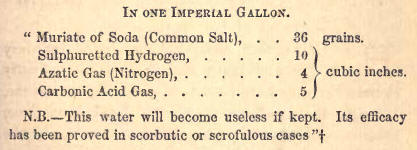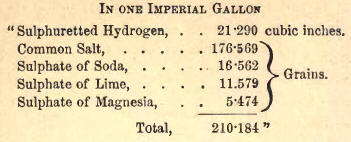|
Mineral Wells.—Sulphurous
Spring—Its Analysts, Mackaile, Sir Robert Sibbald, Thomas Garnett, Dr. T.
Thomson, Dr. Macadam, D. Murray Thomson, with remarks on the Analyses—Early
influence of the Well on the general aspect of the Town--Its Visitors.
HAVING already made reference to the discovery of the
principal well, we shall now briefly sketch its history from that date to
the present tune, noticing the numerous analyses which have been effected,
with remarks on the opinions expressed in the reports of the respective
analysts above mentioned. Although not much resorted to, it was not long
till its peculiarities and curative powers attracted the attention of the
Faculty, for we find one Matthew Mackaile, an Edinburgh physician, in a
curious little work, giving a description of the well, its ingredients, and
therapeutic effects. In 1677, Mackaile continued his description in a
smaller work of less pretensions, and Sir Robert Sibbald, in 1684, gave
illustrations of the cures effected by the drinking of the waters, which
tended to briug it into greater repute ultimately, and gave the people
greater confidence in it. Since then the analyses have been numerous, all,
or nearly all of which in some important point vary. In the year 1797, Dr.
Thomas Garnett, Professor of Natural Philosophy and Chemistry in the Royal
Institution of Great Britain, during a visit to Moffat, xnade'an analysis of
the spring, taking a wine gallon of mineral water for the purpose, but which
analysis, since Drs. Thomson and Macadam's, cannot be fully relied upon. We
append Garnett's analysis :-

Dr. Thomas Thomson, Professor of Chemistry in the
University of Glasgow in 1823, made an analysis which immediately destroyed
the favourable effect of the previous analysis in the minds of the people.
Dr. Macadam, one of the latest analysts, points out the difference betwixt
Thomson's analysis and that of Garnett's, made twenty-six years before. The
following is Thomson's

Dr. Macadam accounts for his report being at variance
with others in the following:—" It is now many years since the experiments
of Dr. Thomson were made. It is conceivable that the waters may be somewhat
different in nature and composition from what they were at the period of his
examination. This at all events is certain, that Analytical Chemistry has
since then made great advances, and that our instrumental means of inquiry
have been most materially improved." Through the kindness of Messrs.
l3lackie & Sons, publishers, we are enabled to give Macadam's Analysis.
Macadam not only differs from the opinions of other medical men in his
analysis regarding the water itself, but also in the smell which arises from
it, and which, in a few cases, causes parties to refrain from drinking it,
even in pursuit of health. Dr. Garnett said it had a "strong smell,
resembling bilge-water or the scourings of a foul gun," while Macadam states
it is more like the smell of a "slightly putrescent egg," which our
individual experience has taught us. On account of a bog being at one time
in close proximity to the well, it was believed that in conjunction with the
pyrites in the greywacke, from which species of rock the water oozes out,
this was the origin of the sulphurous impregnation of the Moffat water. But
this has, by Dr. Macadam, been cast aside as a ridiculous surmise, because
the bog is gone, and still there is no perceptible diminution of the mineral
water.
The rocks surrounding the well have
been declared upon examination to contain sulphur to a great extent, "In the
form of iron pyrites or bis-suiphuret of iron," and the rock from which the
mineral stream proceeds, according to Macadam's report, contains to some
extent the same ingredient. The fact of parties being attracted from all
parts of the United Kingdom to this well, proves the efficacy of the mineral
stream; and since many have testified to their having received material good
from it, we need not attempt (we could not though we would) to detract from
the fame of Moffat., emphatically styled the "Cheltenham of Scotland," by
ignoring the prevalent belief embodied in medical reports, that the drinking
of this water is attended by a therapeutic effect it is a matter of some
difficulty to determine the numbers at different dates drawn by the 'well to
Moffat, as we have not had the means of ascertaining put in our way. It
cannot, however, be said that the numbers were similar year by year. It has
been foolishly asserted that in 1679, twenty years after the publication of
Mackaile's first treatise, Moffat became a place of note. "It is probable,"
says one writer, "these early visitors were nearly all people afflicted with
some real ailment; but by-and-by it became a place of fashionable resort,
without any special reference to the mere matter of health. Instead of
"nearly all," we feel certain all were at this period drawn to Moffat like
the invalid to the physician; and that a much greater space of time elapsed
ere it became a place of retreat for the fashionable. Of this we shall speak
in another chapter in relation to the progress of the town.
|

